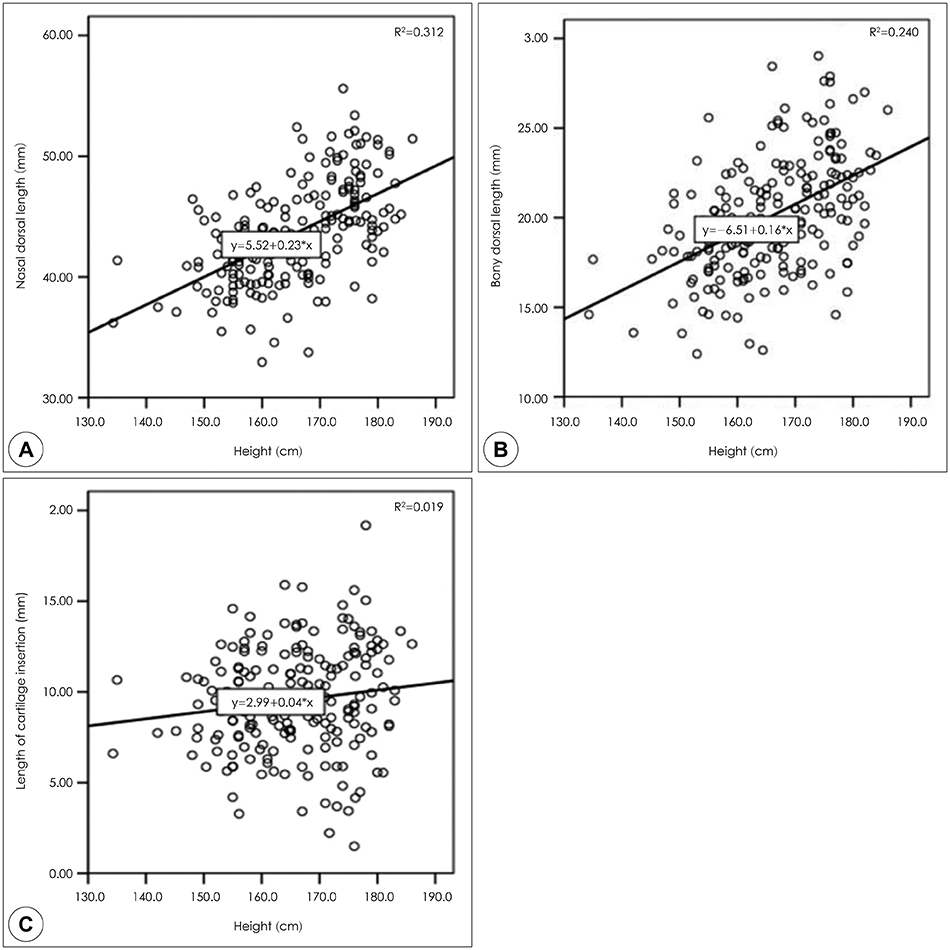J Rhinol.
2019 Nov;26(2):75-81. 10.18787/jr.2019.26.2.75.
Radiologic Measurement of the Nasal Length and Keystone Area in Relation to Nasal Bony and Septal Cartilaginous Dimensions in Korean Adults
- Affiliations
-
- 1Department of Otolaryngology-Head and Neck Surgery, Asan Medical Center, University of Ulsan College of Medicine, Seoul, Korea. 3712yjang@gmail.com
- KMID: 2465537
- DOI: http://doi.org/10.18787/jr.2019.26.2.75
Abstract
- BACKGROUND AND OBJECTIVES
To measure nasal length and keystone area on sagittal plane computed tomography.
MATERIALS AND METHODS
The medical records and radiographic data of 200 patients were evaluated. The length of the nasal dorsum and the bony dorsum, and the length and angle of cartilage overlap at the keystone were measured. Measurements were compared according to sex and the correlation between nasal length and patient height was analyzed.
RESULTS
The mean length (mm) of the nasal dorsum was 46.1±3.7 in men and 41.0±2.7 in women (p<0.01). The mean length of the bony dorsum was 17.6±3.0 (38.1% of the nasal dorsal length) in men and 15.6±2.3 (37.9%) in women (p<0.01). The mean length of the cartilage overlap in the keystone area was 9.8±3.3 and 9.2±2.4 for men and women, respectively. The angle of cartilage overlap in the keystone area varied from 30.4 to 154.2 degrees. Patient height was positively correlated with both the length of the nasal dorsum and the bony dorsum (p<0.01 for both).
CONCLUSION
The nose is longer in men than in women. We found a positive correlation between patient height and nasal length. The cartilaginous dorsum extends under the nasal bone for approximately 9.5 mm.
Figure
Reference
-
1. Rohrich RJ, Adams WP, Ahmad J, Gunter J. Dallas rhinoplasty: nasal surgery by the masters. CRC Press;2014.2. Saharia PS, Deepti S. Septoplasty can Change the Shape of the Nose. Indian J Otolaryngol Head Neck Surg. 2013; 65(Suppl 2):220–225.
Article3. Lam SM, Williams EF 3rd. Anatomic considerations in aesthetic rhinoplasty. Facial Plast Surg. 2002; 18(4):209–214.
Article4. Teymoortash A, Fasunla JA, Sazgar AA. The value of spreader grafts in rhinoplasty: a critical review. Eur Arch Otorhinolaryngol. 2012; 269(5):1411–1416.
Article5. Kim YD. Septoplasty and turbinoplasty; current concept and technique. Journal of Rhinology. 2012; 19(1):19–28.6. Song SH, Nam WH, Kim JS. Anchoring suture for correction of septal deviation. Journal of Rhinology. 2006; 13(1):18–21.7. Carr S, Twigg V, Mirza S. Radiological study of the anatomy of the keystone area of the nasal septum using computed tomography to aid septal surgery. Clin Otolaryngol. 2016; 41(4):317–320.
Article8. Palhazi P, Daniel RK, Kosins AM. The osseocartilaginous vault of the nose: anatomy and surgical observations. Aesthet Surg J. 2015; 35(3):242–251.
Article9. Tuncel U, Turan A, Kostakoglu N. Digital anthropometric shape analysis of 110 rhinoplasty patients in the Black Sea Region in Turkey. J Craniomaxillofac Surg. 2013; 41(2):98–102.
Article10. Leong SC, White PS. A comparison of aesthetic proportions between the Oriental and Caucasian nose. Clin Otolaryngol Allied Sci. 2004; 29(6):672–676.
Article11. Wang JH, Jang YJ, Park SK, Lee BJ. Measurement of aesthetic proportions in the profile view of Koreans. Ann Plast Surg. 2009; 62(2):109–113.
Article12. Li KZ, Guo S, Sun Q, Jin SF, Zhang X, Xiao M, et al. Anthropometric nasal analysis of Han Chinese young adults. J Craniomaxillofac Surg. 2014; 42(2):153–158.
Article13. Godley FA. Nasal septal anatomy and its importance in septal reconstruction. Ear Nose Throat J. 1997; 76(8):498–501.
Article14. Kim IS, Lee MY, Lee KI, Kim HY, Chung YJ. Analysis of the Development of the Nasal Septum according to Age and Gender Using MRI. Clin Exp Otorhinolaryngol. 2008; 1(1):29–34.
Article15. Kim IS, Chung YJ, Lee YI. An anatomic study on the overlap patterns of structural components in the keystone area in noses of koreans. Clin Exp Otorhinolaryngol. 2008; 1(3):158–160.
Article
- Full Text Links
- Actions
-
Cited
- CITED
-
- Close
- Share
- Similar articles
-
- Anatomical and Radiologic Analysis of Keystone Area of Korean Nose
- An Anatomic Study on the Overlap Patterns of Structural Components in the Keystone Area in Noses of Koreans
- Analysis of the Development of the Nasal Septum according to Age and Gender Using MRI
- A Case of Septal Abscess Extending to the Nasal Dorsum
- Surgical anatomy for Asian rhinoplasty: Part II



